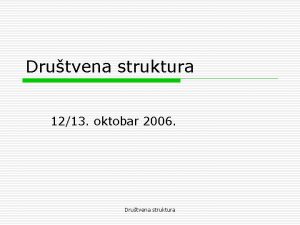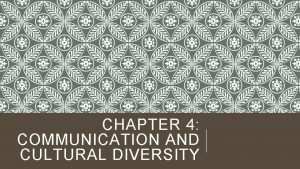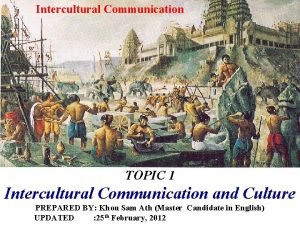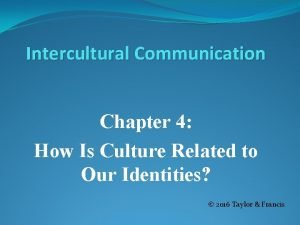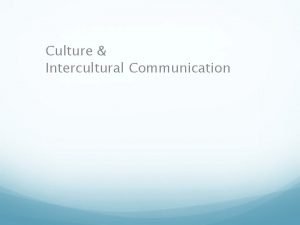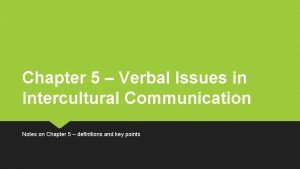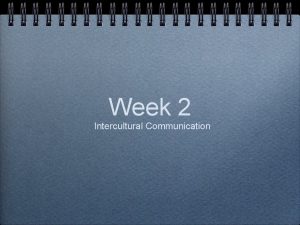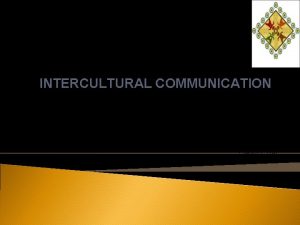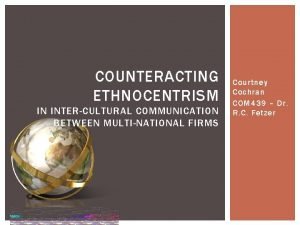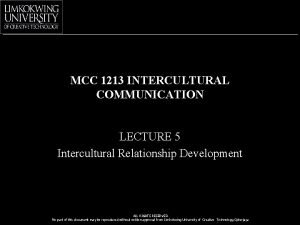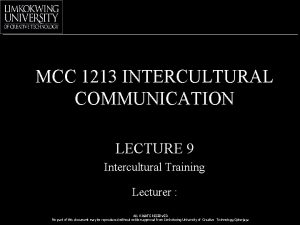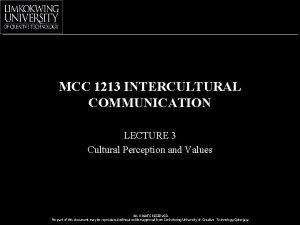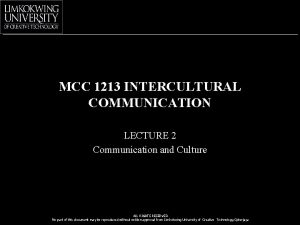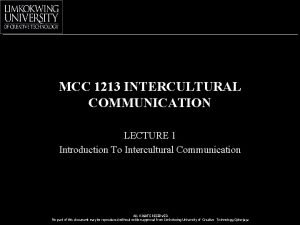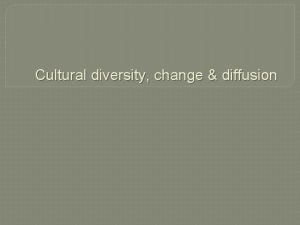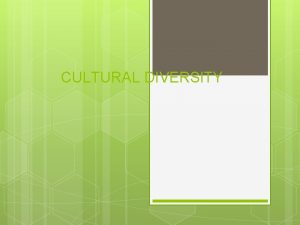MCC 1213 INTERCULTURAL COMMUNICATION LECTURE 8 Cultural Diversity














- Slides: 14

MCC 1213 INTERCULTURAL COMMUNICATION LECTURE 8 Cultural Diversity and Multiculturalism Lecturer : ALL RIGHTS RESERVED No part of this document may be reproduced without written approval from Limkokwing University of Creative Technology, Cyberjaya

LEARNING OUTCOME • Gain insight into the challenge of cultural diversity • Understand cultural diversity in organization • Know how to manage a culturally diverse work force ALL RIGHTS RESERVED No part of this document may be reproduced without written approval from Limkokwing University of Creative Technology, Cyberjaya

• Understand the stages of the multiculturalism process • Know the meaning and components of intercultural sensititvity ALL RIGHTS RESERVED No part of this document may be reproduced without written approval from Limkokwing University of Creative Technology, Cyberjaya

• “Who a person is” results both from socialization into “the ways of a nation” and from ethnic, cultural and gender socialization • Persons who identify strongly with domestic co-cultures, as well as those who have arrived recently from other nations, experience a tension between national and ethnic identity that may or may not decrease over time ALL RIGHTS RESERVED No part of this document may be reproduced without written approval from Limkokwing University of Creative Technology, Cyberjaya

5 DEMOGRAPHIC FACTORS (CREATING IMPACT) • The Population and the workforce will grow more slowly (slow expansion of economy more towards luxury goods and convenience services) • The average of the population and the workforce will rise, and the pool of young workers entering the labor market will shrink ALL RIGHTS RESERVED No part of this document may be reproduced without written approval from Limkokwing University of Creative Technology, Cyberjaya

• More women will enter the workforce (demand for day care, pregnancy leave, child-rearing assistance, flexible and stay-at-home jobs) • Co-cultural groups will constitute a larger share of new entrants into the labor force • Immigrants will represent the largest share of the increase in the population and the workforce ALL RIGHTS RESERVED No part of this document may be reproduced without written approval from Limkokwing University of Creative Technology, Cyberjaya

MANAGING A CULTURALLY DIVERSE WORKFORCE 3 operational principles: 1. Planning – Organizations need to plan ahead – Incorporate systems into the working environment through which a further understanding of cultural diversity – Ability to function as global entities ALL RIGHTS RESERVED No part of this document may be reproduced without written approval from Limkokwing University of Creative Technology, Cyberjaya

– Ethnic and gender differences at all positions and levels – Ideal planning for a company: (1) a cultural and global inspiring mission, (2) a cultural and global corporate vision, (3) cultural and global information sources and system, and (4) decision making criteria that reflect global and local cultural values (Rhinesmith 1991) ALL RIGHTS RESERVED No part of this document may be reproduced without written approval from Limkokwing University of Creative Technology, Cyberjaya

2. Organization – Need to recognize their policies and program – Promote awareness and appreciation of cultural diversity – The effort to accommodate cultural diversity should aim to bring a new and richer business outlook ALL RIGHTS RESERVED No part of this document may be reproduced without written approval from Limkokwing University of Creative Technology, Cyberjaya

3. Leadership – To scan the global and multicultural environment for trends and ruptures – To develop global and multicultural visions and mindsets – To build global and cross-cultural bridges and alliances ALL RIGHTS RESERVED No part of this document may be reproduced without written approval from Limkokwing University of Creative Technology, Cyberjaya

– To reframe global and multicultural problems to create new solutions – To communicate cross-culturally in an effective way – To practice global and multiculturalism team leadership in an environment of equals – To develop a global and diverse corporate culture (Rhinesmith, 1991) ALL RIGHTS RESERVED No part of this document may be reproduced without written approval from Limkokwing University of Creative Technology, Cyberjaya

TECHNIQUES FOR DIVERSITY MANAGEMENT IN ORGANIZATIONS • Managing and rewarding performance based on the foundation of diversity • Matching people and jobs • Keeping employees informed and involved • Supporting diverse work styles and life needs (Conrad, 1994) ALL RIGHTS RESERVED No part of this document may be reproduced without written approval from Limkokwing University of Creative Technology, Cyberjaya

THE NEED FOR INTERCULTURAL SENSITIVITY • Define: sensitivity as mind-set applied in one’s everyday life whereby one accepts personal complexity, avoids communication inflexibility, interacts consciously, appreciates the ideas exchanged, and tolerates intentional searching. ALL RIGHTS RESERVED No part of this document may be reproduced without written approval from Limkokwing University of Creative Technology, Cyberjaya

• Creating ethno relativism – assuming that the world-view of one’s own culture is central to all reality (Bennett, 1984) • How to create ethno relativism – (1) respect for cultural differences, (2) adaptability, (3) perspective-taking, (4) open-mindedness (5) acknowledgement of other’s needs ALL RIGHTS RESERVED No part of this document may be reproduced without written approval from Limkokwing University of Creative Technology, Cyberjaya
 Drustveno delanje
Drustveno delanje Chapter 4 communication and cultural diversity
Chapter 4 communication and cultural diversity Cultural diversity 3939 answers
Cultural diversity 3939 answers Barriers intercultural communication
Barriers intercultural communication Intercultural communication meaning
Intercultural communication meaning Questions about intercultural communication
Questions about intercultural communication Avowal and ascription
Avowal and ascription Intercultural communication meaning
Intercultural communication meaning Intercultural communication notes
Intercultural communication notes Staircase model of intercultural communication
Staircase model of intercultural communication Example of verbal intercultural communication
Example of verbal intercultural communication Nonverbal intercultural communication
Nonverbal intercultural communication Intercultural communication conclusion
Intercultural communication conclusion Ethnocentrism intercultural communication
Ethnocentrism intercultural communication Intercultural communication model
Intercultural communication model
